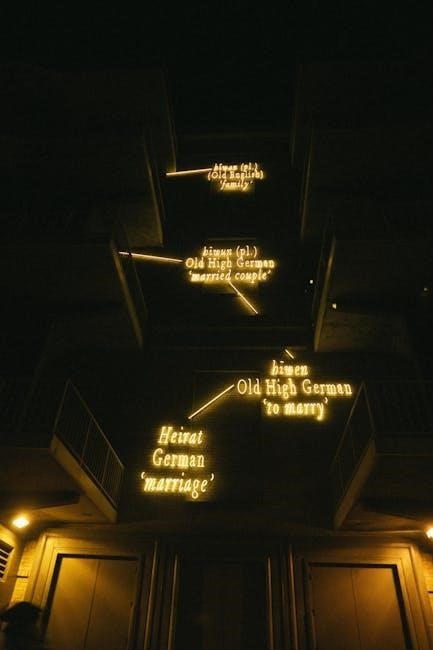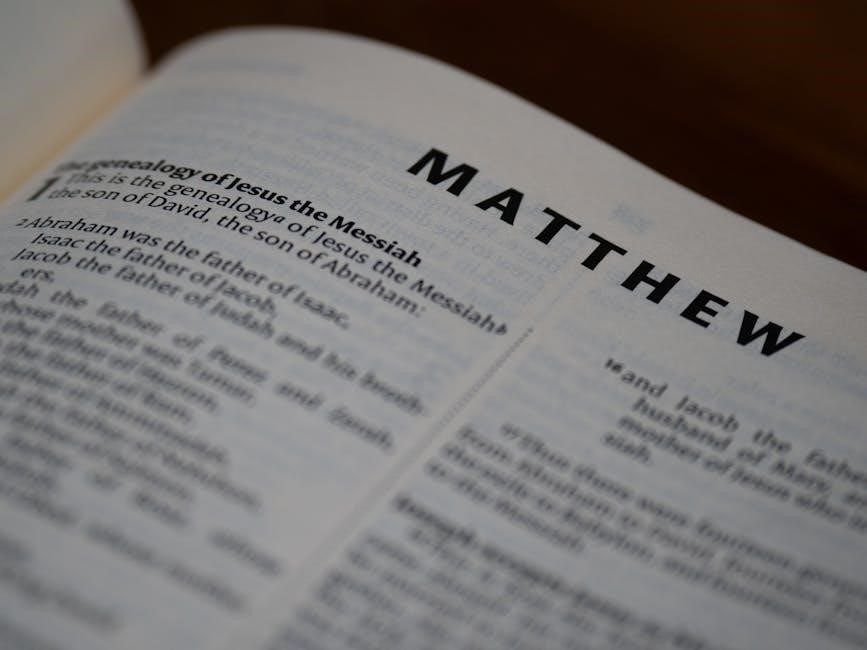The Garima Gospels are ancient illuminated manuscripts discovered in the 18th century by an Ethiopian monk, dating back to the 6th century. They are among the earliest surviving Christian manuscripts, containing the Gospels of Matthew, Mark, Luke, and John. These texts hold significant religious and historical value, offering insights into early Christianity. Their intricate artistic designs and preserved condition make them a treasure for scholars and believers alike. Recently translated into English, the Garima Gospels are now accessible to a broader audience, bridging ancient traditions with modern understanding.
Overview of the Garima Gospels

The Garima Gospels are among the oldest illuminated Christian manuscripts, dating back to the 6th century. They contain the Gospels of Matthew, Mark, Luke, and John, written in the Ge’ez language, which is an ancient liturgical language of the Ethiopian Church. These manuscripts are remarkable for their vibrant illustrations and well-preserved condition, making them a significant artifact in religious and historical studies. The gospels are named after Abba Garima, the Ethiopian monk who reportedly translated the texts from Greek to Ge’ez. Their artistic and theological content provides valuable insights into early Christian traditions and practices. The discovery and translation of these texts have opened new avenues for scholars to explore the evolution of biblical narratives and their cultural impact. The Garima Gospels are not only a religious treasure but also a testament to the rich cultural heritage of Ethiopia.
Significance of the Garima Gospels in Biblical Studies
The Garima Gospels hold immense significance in biblical studies as one of the earliest surviving illuminated Christian manuscripts. Dating back to the 6th century, they provide a unique window into early Christian theology, offering insights into the textual transmission of the Gospels. Their translation into English has made them accessible to a global audience, fostering deeper understanding and comparative analysis with other biblical texts. The manuscripts are particularly valuable for their historical and linguistic contributions, revealing the evolution of biblical narratives through the centuries. Additionally, their artistic illustrations offer a visual narrative of early Christian iconography, enriching the study of religious art and symbolism. The Garima Gospels are thus a vital resource for scholars, bridging ancient traditions with modern biblical research and enhancing our understanding of Christianity’s early development.

Historical Context of the Garima Gospels
The Garima Gospels, dating to the 6th century, are among the earliest surviving illuminated Christian manuscripts. They were likely created in the Byzantine Empire and later brought to Ethiopia, where they were preserved for centuries. Discovered in the 20th century by an Italian mission, these texts are older than the Rabbula Gospels, making them a significant historical find. Their intricate illustrations and well-preserved condition provide a rare glimpse into early Christian art and theology, making them a cornerstone of biblical history and cultural heritage.
The Discovery and Dating of the Garima Gospels
The Garima Gospels were discovered in the 18th century by an Ethiopian monk named Abba Garima, who found them in a monastery in Tigray, Ethiopia. Initially believed to date back to the 7th or 8th century, radiocarbon dating later confirmed their origin to the 6th century, making them one of the earliest surviving illuminated Christian manuscripts. Their discovery was a significant archaeological find, as they predate other well-known manuscripts like the Rabbula Gospels. The texts were later brought to Europe in the 20th century for study and preservation, where scholars further analyzed their historical and artistic value. The dating process involved meticulous examination of the parchment, ink, and stylistic elements, confirming their antiquity. This discovery has provided invaluable insights into early Christian art and theology, solidifying their place as a cornerstone of biblical history.

The Illuminated Manuscripts and Their Artistic Value
The Garima Gospels are renowned for their exquisite illuminated manuscripts, which are among the earliest and most well-preserved examples of Christian art. The manuscripts feature intricate illustrations of biblical scenes, including portraits of the Evangelists Matthew, Mark, Luke, and John. The artistic style reflects a blend of Byzantine and early Christian influences, with vibrant colors and complex compositions. These miniatures are not only aesthetically remarkable but also provide a unique window into the artistic traditions of the early Christian world. The high quality of the illustrations and the sophisticated use of color demonstrate a level of craftsmanship that was rare for their time. The Garima Gospels are considered a masterpiece of early Christian art and continue to inspire art historians and scholars today. Their artistic value is further enhanced by their historical significance, making them a treasure of both religious and cultural heritage.

Translation of the Garima Gospels into English
The Garima Gospels have been translated into English, preserving their historical and theological significance. This translation involved careful editing and interpretation of the ancient texts, ensuring accuracy and readability. The English version makes the Gospels accessible to a broader audience, fostering a deeper understanding of early Christian teachings.
The Process of Translating Ancient Texts into Modern English
Translating ancient texts like the Garima Gospels into modern English involves a meticulous process to ensure accuracy and preservation of meaning. Scholars begin by carefully transcribing the original Ge’ez text, considering its linguistic nuances and historical context. The next step is translating the content while maintaining the theological and cultural depth. This requires a deep understanding of both the source language and the target language. Additionally, interpreters analyze the text to clarify ambiguous phrases and ensure the translation remains faithful to the original intent. The process also includes proofreading and peer review to verify the accuracy of the final product. Modern technology, such as digital tools and databases, aids in cross-referencing and maintaining consistency. The result is a readable and accessible English version that bridges the gap between ancient traditions and contemporary readers, making the Garima Gospels available to a global audience;
Key Challenges in Translating the Garima Gospels
Translating the Garima Gospels into modern English presents several challenges, primarily due to the ancient nature of the text. The manuscripts, dating back to the 6th century, are written in Ge’ez, an archaic language that requires specialized expertise. Scholars must decipher faded or damaged sections, ensuring no loss of meaning. Additionally, the theological and cultural nuances of the original text must be preserved while making it accessible to contemporary readers. Maintaining the balance between literal accuracy and fluid English is a delicate task. Another challenge is the integration of illuminated artwork, which must be described without diverting from the textual content. Furthermore, the historical context of the Gospels must be considered to avoid misinterpretation. These obstacles highlight the complexity of translating such a valuable and fragile manuscript into a modern language while honoring its original intent and artistic heritage.

Availability of the Garima Gospels in English Translation
The Garima Gospels English translation is now accessible online, with PDF versions available for download. Reliable platforms like Open Library and Academia.edu provide free access to the translated manuscript.
Where to Download the Garima Gospels English Translation PDF
The Garima Gospels English translation PDF is readily available for download on several reputable online platforms. Open Library, with its vast collection of over 1 million free eBooks, offers a direct link to download the Garima Gospels in PDF format. Additionally, Academia.edu provides access to the translated manuscript, allowing users to explore and download it for free. Other reliable sources include the National Library of Russia in Saint Petersburg, which houses the original manuscripts and offers digital versions for research purposes. To download, simply visit these platforms, search for “Garima Gospels English Translation PDF,” and follow the provided instructions. These resources ensure that the ancient text is accessible to a global audience, preserving its historical and religious significance for future generations.
Reliable Platforms for Accessing the Translation
Accessing the Garima Gospels English translation PDF is straightforward through several reliable platforms. Open Library stands out as a premier source, offering the manuscript as part of its extensive collection of free eBooks. Users can easily download the PDF by searching for “Garima Gospels English Translation” on the platform. Academia.edu is another trusted repository, providing academic access to the translated text, which is particularly useful for researchers and scholars. Additionally, the Walters Art Museum’s digital collection includes high-resolution images of the illuminated manuscripts, complementing the English translation. These platforms ensure that the Garima Gospels are widely accessible while maintaining their historical and cultural integrity. By utilizing these resources, readers can explore the manuscripts’ religious and artistic significance with ease and convenience.
Cultural and Religious Impact
The Garima Gospels, as one of the oldest illuminated Christian manuscripts, deeply influence religious traditions and cultural heritage. Their English translation enhances accessibility, preserving their spiritual and historical significance for modern audiences globally.
The Garima Gospels and Their Influence on Christianity
The Garima Gospels, among the oldest illuminated Christian manuscripts, hold profound significance in shaping religious practices and beliefs. Dating back to the 6th century, these texts are invaluable for understanding early Christianity; Their intricate illustrations and preserved narratives provide insights into the cultural and spiritual practices of the time. The translation into English has expanded their reach, allowing global audiences to engage with their teachings. This accessibility has deepened theological studies and enriched spiritual reflection, making the Garima Gospels a cornerstone of Christian heritage. Their influence extends beyond academia, inspiring devotion and fostering a connection to ancient traditions. By bridging centuries, they continue to inform and inspire modern Christian communities.
Modern Relevance of the Garima Gospels

The Garima Gospels remain a vital resource for modern religious and academic exploration due to their historical and spiritual significance. Their recent English translation has made them accessible to a global audience, fostering a deeper understanding of early Christian traditions. Digital platforms now offer free PDF downloads of the translation, enabling widespread access for scholars, students, and enthusiasts. This availability has sparked renewed interest in their artistic and theological content, bridging ancient traditions with contemporary studies. The manuscripts’ insights into early Christianity continue to inspire theological discussions and personal reflection. As a result, the Garima Gospels are not only a historical treasure but also a living document influencing modern spiritual and academic pursuits.
